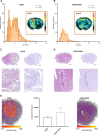Tumor biomechanics as a novel imaging biomarker to assess response to immunotherapy in a murine glioma model
- PMID: 38971907
- PMCID: PMC11227492
- DOI: 10.1038/s41598-024-66519-7
Tumor biomechanics as a novel imaging biomarker to assess response to immunotherapy in a murine glioma model
Abstract
Glioblastoma is the most common and aggressive primary malignant brain tumor with poor prognosis. Novel immunotherapeutic approaches are currently under investigation. Even though magnetic resonance imaging (MRI) is the most important imaging tool for treatment monitoring, response assessment is often hampered by therapy-related tissue changes. As tumor and therapy-associated tissue reactions differ structurally, we hypothesize that biomechanics could be a pertinent imaging proxy for differentiation. Longitudinal MRI and magnetic resonance elastography (MRE) were performed to monitor response to immunotherapy with a toll-like receptor 7/8 agonist in orthotopic syngeneic experimental glioma. Imaging results were correlated to histology and light sheet microscopy data. Here, we identify MRE as a promising non-invasive imaging method for immunotherapy-monitoring by quantifying changes in response-related tumor mechanics. Specifically, we show that a relative softening of treated compared to untreated tumors is linked to the inflammatory processes following therapy-induced re-education of tumor-associated myeloid cells. Mechanistically, combined effects of myeloid influx and inflammation including extracellular matrix degradation following immunotherapy form the basis of treated tumors being softer than untreated glioma. This is a very early indicator of therapy response outperforming established imaging metrics such as tumor volume. The overall anti-tumor inflammatory processes likely have similar effects on human brain tissue biomechanics, making MRE a promising tool for gauging response to immunotherapy in glioma patients early, thereby strongly impacting patient pathway.
Keywords: Glioma; Immunotherapy; MR elastography; Tissue biomechanics; Tumor stiffness.
© 2024. The Author(s).
Conflict of interest statement
The authors declare no competing interests.
Figures






References
-
- Ellingson BM, Chung C, Pope WB, Boxerman JL, Kaufmann TJ. Pseudoprogression, radionecrosis, inflammation or true tumor progression? Challenges associated with glioblastoma response assessment in an evolving therapeutic landscape. J. Neurooncol. 2017;134:495–504. doi: 10.1007/s11060-017-2375-2. - DOI - PMC - PubMed
MeSH terms
Substances
Grants and funding
- R35 GM147184/GM/NIGMS NIH HHS/United States
- 2019_EKMS.23/Else Kröner-Fresenius-Stiftung
- Olympia Morata program/Medizinischen Fakultät Heidelberg, Universität Heidelberg
- cancer grant 2020 DESP/PB no. 241/ITMO Cancer Aviesan INSERM
- Sonderförderlinie 'Neuroinflammation'/Ministerium für Wissenschaft, Forschung und Kunst Baden-Württemberg
- R35GM147184/NH/NIH HHS/United States
- grant no. 32-97/21/Daimler und Benz Stiftung
- grant no. 101068340/EU Horizon TMA MSCA Postdoctoral Fellowship Award
- grant no. 70113515/Deutsche Krebshilfe
- Project ID 404521405, SFB1389/Deutsche Forschungsgemeinschaft
- 2017-A25/Else Kröner-Fresenius-Stiftung
- grant no. 451894423/Deutsche Forschungsgemeinschaft
- National Center for Tumor Diseases Heidelberg NCT 3.0 program 'Precision immunotherapy of brain tumors'/German Ministry of Education and Science
- Mildred-Scheel doctoral program/Deutsche Krebshilfe
LinkOut - more resources
Full Text Sources
Medical
Research Materials

